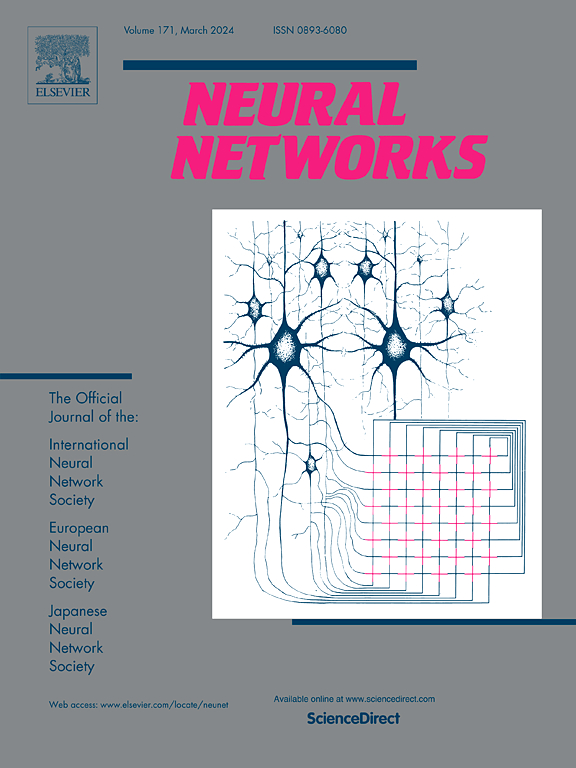Multi-compartment neuron and population encoding powered spiking neural network for deep distributional reinforcement learning
IF 6.3
1区 计算机科学
Q1 COMPUTER SCIENCE, ARTIFICIAL INTELLIGENCE
引用次数: 0
Abstract
Inspired by the brain’s information processing using binary spikes, spiking neural networks (SNNs) offer significant reductions in energy consumption and are more adept at incorporating multi-scale biological characteristics. In SNNs, spiking neurons serve as the fundamental information processing units. However, in most models, these neurons are typically simplified, focusing primarily on the leaky integrate-and-fire (LIF) point neuron model while neglecting the structural properties of biological neurons. This simplification hampers the computational and learning capabilities of SNNs. In this paper, we propose a brain-inspired deep distributional reinforcement learning algorithm based on SNNs, which integrates a bio-inspired multi-compartment neuron (MCN) model with a population coding approach. The proposed MCN model simulates the structure and function of apical dendritic, basal dendritic, and somatic compartments, achieving computational power comparable to that of biological neurons. Additionally, we introduce an implicit fractional embedding method based on population coding of spiking neurons. We evaluated our model on Atari games, and the experimental results demonstrate that it surpasses the vanilla FQF model, which utilizes traditional artificial neural networks (ANNs), as well as the Spiking-FQF models that are based on ANN-to-SNN conversion methods. Ablation studies further reveal that the proposed multi-compartment neuron model and the quantile fraction implicit population spike representation significantly enhance the performance of MCS-FQF while also reducing power consumption.
用于深度分布强化学习的多室神经元和群体编码驱动尖峰神经网络。
尖峰神经网络(SNN)受大脑利用二进制尖峰进行信息处理的启发,可显著降低能耗,并更善于结合多尺度生物特征。在尖峰神经网络中,尖峰神经元是基本的信息处理单元。然而,在大多数模型中,这些神经元通常都被简化了,主要集中在泄漏整合-发射(LIF)点神经元模型上,而忽略了生物神经元的结构特性。这种简化阻碍了 SNN 的计算和学习能力。在本文中,我们提出了一种基于 SNNs 的大脑启发式深度分布强化学习算法,该算法将生物启发式多室神经元(MCN)模型与种群编码方法相结合。所提出的 MCN 模型模拟了顶端树突、基底树突和体细胞区室的结构和功能,实现了与生物神经元相当的计算能力。此外,我们还引入了一种基于尖峰神经元群体编码的隐式分数嵌入方法。我们在 Atari 游戏中对我们的模型进行了评估,实验结果表明它超越了利用传统人工神经网络(ANN)的虚构 FQF 模型,以及基于 ANN 到 SNN 转换方法的 Spiking-FQF 模型。消融研究进一步表明,所提出的多室神经元模型和量子分数隐式群体尖峰表示法显著提高了 MCS-FQF 的性能,同时还降低了功耗。
本文章由计算机程序翻译,如有差异,请以英文原文为准。
求助全文
约1分钟内获得全文
求助全文
来源期刊

Neural Networks
工程技术-计算机:人工智能
CiteScore
13.90
自引率
7.70%
发文量
425
审稿时长
67 days
期刊介绍:
Neural Networks is a platform that aims to foster an international community of scholars and practitioners interested in neural networks, deep learning, and other approaches to artificial intelligence and machine learning. Our journal invites submissions covering various aspects of neural networks research, from computational neuroscience and cognitive modeling to mathematical analyses and engineering applications. By providing a forum for interdisciplinary discussions between biology and technology, we aim to encourage the development of biologically-inspired artificial intelligence.
 求助内容:
求助内容: 应助结果提醒方式:
应助结果提醒方式:


